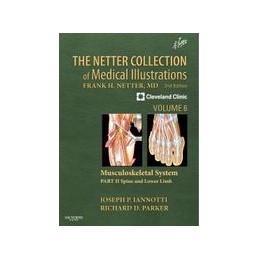- Reduced price

Order to parcel locker

easy pay


 Delivery policy
Delivery policy
Choose Paczkomat Inpost, Orlen Paczka, DHL, DPD or Poczta Polska. Click for more details
 Security policy
Security policy
Pay with a quick bank transfer, payment card or cash on delivery. Click for more details
 Return policy
Return policy
If you are a consumer, you can return the goods within 14 days. Click for more details
The Lower Limb and Spine, Part 2 of The Netter Collection of Medical Illustrations:: Musculoskeletal System, 2nd Edition, provides a highly visual guide to the spine and lower extremity, from basic science and anatomy to orthopaedics and rheumatology. This spectacularly illustrated volume in the masterwork known as the (CIBA) Green Books has been expanded and revised by Dr. Joseph Iannotti, Dr. Richard Parker, and other experts from the Cleveland Clinic to mirror the many exciting advances in musculoskeletal medicine and imaging - offering rich insights into the anatomy, physiology, and clinical conditions of the spine; pelvis, hip, and thigh; knee; lower leg; and ankle and foot.
Data sheet
SECTION 1-SPINE
1-1 Vertebral Column, 2
Cervical Spine
1-2 Atlas and Axis, 3
1-3 External Craniocervical Ligaments, 4
1-4 Internal Craniocervical Ligaments, 5
1-5 Suboccipital Triangle, 6
1-6 Dens Fracture, 7
1-7 Jefferson and Hangmans Fractures, 8
1-8 Cervical Vertebrae, 9
1-9 Muscles of Back: Superficial Layers, 10
1-10 Muscles of Back: Intermediate and
Deep Layers, 11
1-11 Spinal Nerves and Sensory
Dermatomes, 12
1-12 Cervical Spondylosis, 13
1-13 Cervical Spondylosis and
Myelopathy, 14
1-14 Cervical Disc Herniation:
Clinical Manifestations, 15
1-15 Surgical Approaches for the Treatment
of Myelopathy and Radiculopathy, 16
1-16 Extravascular Compression of
Vertebral Arteries, 17
Thoracolumbar and Sacral Spine
1-17 Thoracic Vertebrae and Ligaments, 18
1-18 Lumbar Vertebrae and Intervertebral
Discs, 19
1-19 Sacral Spine and Pelvis, 20
1-20 Lumbosacral Ligaments, 21
1-21 Degenerative Disc Disease, 22
1-22 Lumbar Disc Herniation, 23
1-23 Lumbar Spinal Stenosis, 24
1-24 Lumbar Spinal Stenosis
(Continued), 25
1-25 Degenerative Lumbar
Spondylolisthesis, 26
1-26 Degenerative Spondylolisthesis:
Cascading Spine, 27
1-27 Adult Deformity, 28
1-28 Three-Column Concept of Spinal
Stability and Compression
Fractures, 29
1-29 Compression Fractures
(Continued), 30
1-30 Burst, Chance, and Unstable
Fractures, 31
Deformities of Spine
1-31 Congenital Anomalies of Occipitocervical
Junction, 32
1-32 Congenital Anomalies of Occipitocervical
Junction (Continued), 33
1-33 Synostosis of Cervical Spine (Klippel-Feil
Syndrome), 34
1-34 Clinical Appearance of
Congenital Muscular
Torticollis (Wryneck), 35
1-35 Nonmuscular Causes of
Torticollis, 36
1-36 Pathologic Anatomy of Scoliosis, 37
1-37 Typical Scoliosis Curve Patterns, 38
1-38 Congenital Scoliosis: Closed Vertebral
Types (MacEwen Classification), 39
1-39 Clinical Evaluation of Scoliosis, 40
1-40 Determination of Skeletal Maturation,
Measurement of Curvature, and
Measurement of Rotation, 41
1-41 Braces for Scoliosis, 42
1-42 Scheuermann Disease, 43
1-43 Congenital Kyphosis, 44
1-44 Spondylolysis and Spondylolisthesis, 45
1-45 Myelodysplasia, 46
1-46 Lumbosacral Agenesis, 47
SECTION 2-PELVIS, HIP, AND THIGH
Anatomy
2-1 Superficial Veins and Cutaneous
Nerves, 50
2-2 Lumbosacral Plexus, 52
2-3 Sacral and Coccygeal Plexuses, 53
2-4 Nerves of Buttock, 54
2-5 Femoral Nerve (L2, 3, 4) and Lateral
Femoral Cutaneous Nerve (L2, 3), 55
2-6 Obturator Nerve (L2, 3, 4), 56
2-7 Sciatic Nerve (L4, 5; S1, 2, 3) and
Posterior Femoral Cutaneous Nerve
(S1, 2, 3), 57
2-8 Muscles of Front of Hip and Thigh, 58
2-9 Muscles of Hip and Thigh (Anterior and
Lateral Views), 59
2-10 Muscles of Back of Hip and Thigh, 60
2-11 Bony Attachments of Muscles of Hip
and Thigh: Anterior View, 61
2-12 Bony Attachments of Muscles of Hip
and Thigh: Posterior View, 62
2-13 Cross-Sectional Anatomy of Hip:
Axial View, 63
2-14 Cross-Sectional Anatomy of Hip:
Coronal View, 64
2-15 Cross-Sectional Anatomy of Thigh, 65
2-16 Arteries and Nerves of Thigh:
Anterior Views, 66
2-17 Arteries and Nerves of Thigh:
Deep Dissection (Anterior View), 67
2-18 Arteries and Nerves of Thigh:
Deep Dissection (Posterior view), 68
2-19 Bones and Ligaments at Hip:
Osteology of the Femur, 69
2-20 Bones and Ligaments at Hip:
Hip Joint, 70
Physical Examination
2-21 Physical Examination, 71
Deformities of the Pelvis and Femur
2-22 Proximal Femoral Focal Deficiency:
Radiographic Classification, 72
2-23 Proximal Femoral Focal Deficiency:
Clinical Presentation, 73
2-24 Congenital Short Femur with
Coxa Vara, 74
2-25 Recognition of Developmental Dislocation
of the Hip, 75
2-26 Clinical Findings in Developmental
Dislocation of Hip, 76
2-27 Radiologic Diagnosis of Developmental
Dislocation of Hip, 77
2-28 Adaptive Changes in Dislocated Hip That
Interfere with Reduction, 78
2-29 Device for Treatment of Clinically
Reducible Dislocation of Hip, 79
2-30 Blood Supply to Femoral Head
in Infancy, 80
2-31 Legg-Calve-Perthes Disease:
Pathogenesis, 81
2-32 Legg-Calve-Perthes Disease:
Physical Examination, 82
2-33 Legg-Calve-Perthes Disease:
Physical Examination (Continued), 83
2-34 Stages of Legg-Calve-Perthes
Disease, 84
2-35 Legg-Calve-Perthes Disease: Lateral Pillar
Classification, 85
2-36 Legg-Calve-Perthes Disease: Conservative
Management, 86
2-37 Femoral Varus Derotational
Osteotomy, 87
2-38 Innominate Osteotomy, 88
2-39 Innominate Osteotomy (Continued), 89
2-40 Physical Examination and Classification
of Slipped Capital Femoral
Epiphysis, 90
2-41 Pin Fixation in Slipped Capital Femoral
Epiphysis, 91
Disorders of the Hip
2-42 Hip Joint Involvement in
Osteoarthritis, 92
2-43 Total Hip Replacement: Prostheses, 93
2-44 Total Hip Replacement: Steps 1 to 3, 94
2-45 Total Hip Replacement: Steps 4 to 8, 95
2-46 Total Hip Replacement: Steps 9 to 12, 96
2-47 Total Hip Replacement:
Steps 13 to 18, 97
2-48 Total Hip Replacement:
Steps 19 and 20, 98
2-49 Total Hip Replacement: Dysplastic
Acetabulum, 99
2-50 Total Hip Replacement:
Protrusio Acetabuli, 100
2-51 Total Hip Replacement: Complications-
Loosening of Femoral Component, 101
2-52 Total Hip Replacement: Complications-
Fractures of Femur and Femoral
Component, 102
2-53 Total Hip Replacement: Complications-
Loosening of Acetabular Component
and Dislocation of Total Hip
Prosthesis, 103
2-54 Total Hip Replacement: Infection, 104
2-55 Total Hip Replacement: Hemiarthroplasty
of Hip, 105
2-56 Hip Resurfacing, 106
2-57 Rehabilitation after Total Hip
Replacement, 107
2-58 Femoroacetabular Impingement/
Hip Labral Tears, 108
2-59 Avascular Necrosis, 109
2-60 Trochanteric Bursitis, 110
2-61 Snapping Hip (Coxa Saltans), 111
2-62 Muscle Strains, 112
Trauma
2-63 Injury to Pelvis: Stable Pelvic Ring
Fractures, 113
2-64 Injury to Pelvis: Straddle Fracture
and Lateral Compression Injury, 114
2-65 Injury to Pelvis: Open Book
Fracture, 115
2-66 Injury to Pelvis: Vertical Shear
Fracture, 116
2-67 Injury to Hip: Acetabular
Fractures, 117
2-68 Injury to Hip: Acetabular Fractures
(Continued), 118
2-69 Injury to Hip: Posterior Dislocation
of Hip, 119
2-70 Injury to Hip: Anterior Dislocation of Hip,
Obturator Type, 120
2-71 Injury to Hip: Dislocation of
Hip with Fracture of Femoral
Head, 121
2-72 Injury to Femur: Intracapsular
Fracture of Femoral Neck, 122
2-73 Injury to Femur: Intertrochanteric
Fracture of Femur, 123
2-74 Injury to Femur: Subtrochanteric
Fracture of Femur, 124
2-75 Injury to Femur: Fracture of Shaft
of Femur, 125
2-76 Injury to Femur: Fracture of Distal
Femur, 126
2-77 Amputation of Lower Limb and
Hip (Disarticulation and
Hemipelvectomy), 127
SECTION 3-KNEE
Anatomy
3-1 Topographic Anatomy of the Knee, 130
3-2 Osteology of the Knee, 131
3-3 Knee: Lateral and Medial Views, 132
3-4 Knee: Anterior Views, 133
3-5 Knee: Posterior and Sagittal Views, 134
3-6 Knee: Interior View and Cruciate and
Collateral Ligaments, 135
3-7 Arteries and Nerves of Knee, 136
Injury to the Knee
3-8 Arthrocentesis of Knee Joint, 137
3-9 Types of Meniscal Tears and Discoid
Meniscus Variations, 138
3-10 Tears of the Meniscus, 139
3-11 Medial and Lateral Meniscus, 140
3-12 Rupture of the Anterior Cruciate
Ligament, 141
3-13 Lateral Pivot Shift Test for Anterolateral
Knee Instability, 142
3-14 Rupture of Cruciate Ligaments:
Arthroscopy, 143
3-15 Rupture of Posterior Cruciate
Ligament, 144
3-16 Physical Examination of the Leg
and Knee, 145
3-17 Sprains of Knee Ligaments, 146
3-18 Disruption of Quadriceps Femoris
Tendon or Patellar Ligament, 147
3-19 Dislocation of Knee Joint, 148
Disorders of the Knee
3-20 Progression of Osteochondritis
Dissecans, 149
3-21 Osteonecrosis, 150
3-22 Tibial Intercondylar Eminence
Fracture, 151
3-23 Synovial Plica, 152
3-24 Synovial Plica (Arthroscopy), Bursitis, and
Iliotibial Band Friction Syndrome, 153
3-25 Pigmented Villonodular Synovitis and
Meniscal Cysts, 154
3-26 Rehabilitation after Injury to Knee
Ligaments, 155
3-27 Bipartite Patella and Bakers Cyst, 156
3-28 Subluxation and Dislocation of
Patella, 157
3-29 Fracture of the Patella, 158
3-30 Osgood-Schlatter Lesion, 159
3-31 Knee Arthroplasty: Osteoarthritis of
the Knee, 160
3-32 Knee Arthroplasty: Total Condylar
Prosthesis and Unicompartmental
Prosthesis, 161
3-33 Knee Arthroplasty: Posterior Stabilized
Knee Prosthesis, 162
3-34 Total Knee Replacement Technique:
Steps 1 to 5, 163
3-35 Total Knee Replacement Technique:
Steps 6 to 9, 164
3-36 Total Knee Replacement Technique:
Steps 10 to 14, 165
3-37 Total Knee Replacement Technique:
Steps 15 to 20, 166
3-38 Medial Release for Varus Deformity
of Knee, 167
3-39 Lateral Release for Valgus Deformity
of Knee, 168
3-40 Rehabilitation after Total Knee
Replacement, 169
3-41 High Tibial Osteotomy for Varus
Deformity of Knee, 170
3-42 Below-Knee Amputation, 171
3-43 Disarticulation of Knee and Above-Knee
Amputation, 172
SECTION 4-LOWER LEG
Anatomy
4-1 Topographic Anatomy of the Lower
Leg, 174
4-2 Fascial Compartments of Leg, 175
4-3 Muscles of Leg: Superficial Dissection
(Anterior View), 176
4-4 Muscles of Leg: Superficial Dissection
(Lateral View), 177
4-5 Muscles, Arteries, and Nerves of Leg:
Deep Dissection (Anterior View), 178
4-6 Muscles of Leg: Superficial Dissection
(Posterior View), 179
4-7 Muscles of Leg: Intermediate Dissection
(Posterior View), 180
4-8 Muscles, Arteries, and Nerves of Leg:
Deep Dissection (Posterior View), 181
4-9 Common Peroneal Nerve, 182
4-10 Tibial Nerve, 183
4-11 Tibia and Fibula, 184
4-12 Tibia and Fibula (Continued), 185
4-13 Bony Attachments of Muscles of Leg, 186
Injury to Lower Leg
4-14 Fracture of Proximal Tibia Involving
Articular Surface, 187
4-15 Fracture of Shaft of Tibia, 188
4-16 Fracture of Tibia in Children, 189
Congenital Deformities
4-17 Bowleg and Knock-Knee, 190
4-18 Blount Disease, 191
4-19 Toeing In: Metatarsus Adductus and
Internal Tibial Torsion, 192
4-20 Toeing In: Internal Femoral Torsion, 193
4-21 Toeing Out and Postural Torsional Effects
on Lower Limbs, 194
SECTION 5-ANKLE AND FOOT
Anatomy
5-1 Surface Anatomy and Muscle Origins
and Insertions, 196
5-2 Tendon Sheaths of Ankle, 197
5-3 Ligaments and Tendons of Ankle, 198
5-4 Dorsal Foot: Superficial Dissection, 199
5-5 Dorsal Foot: Deep Dissection, 200
5-6 Plantar Foot: Superficial Dissection, 201
5-7 Plantar Foot: First Layer, 202
5-8 Plantar Foot: Second Layer, 203
5-9 Plantar Foot: Third Layer, 204
5-10 Interosseous Muscles and Deep Arteries
of Foot, 205
5-11 Cross-Sectional Anatomy of Ankle
and Foot, 206
5-12 Cross-Sectional Anatomy of Ankle
and Foot (Continued), 207
5-13 Bones of Foot, 208
5-14 Bones of Foot (Continued), 209
5-15 Ligaments and Tendons of Foot:
Plantar View, 210
5-16 Lymph Vessels and Nodes of Lower
Limb, 211
Fractures and Dislocations
5-17 Major Sprains and Sprain Fractures, 212
5-18 Mechanisms of Ankle Sprains, 213
5-19 Rotational Fractures, 214
5-20 Repair of Fracture of Malleolus, 215
5-21 Pilon Fracture, 216
5-22 Talus Fracture, 217
5-23 Extra-articular Fracture of Calcaneus, 218
5-24 Intra-articular Fracture of Calcaneus, 219
5-25 Fifth Metatarsal Fractures, 220
5-26 Lisfranc Injury, 221
5-27 Navicular Stress Fractures, 222
Common Soft Tissue Disorders
5-28 Achilles Tendon Rupture, 223
5-29 Peroneal Tendon Injury, 224
5-30 Osteochondral Lesions of the
Talus, 225
5-31 Turf Toe, 226
5-32 Plantar Fasciitis, 227
5-33 Posterior Tibial Tendonitis/Flatfoot, 228
Deformities of the Ankle and Foot
5-34 Congenital Clubfoot, 229
5-35 Congenital Clubfoot (Continued), 230
5-36 Congenital Vertical Talus, 231
5-37 Cavovarus Foot, 232
5-38 Calcaneovalgus and Planovalgus, 233
5-39 Tarsal Coalition, 234
5-40 Tarsal Coalition (Continued), 235
5-41 Accessory Tarsal Navicular, 236
5-42 Congenital Toe Deformities, 237
5-43 Köhler Disease, 238
Infections and Amputations
5-44 Common Foot Infections, 239
5-45 Deep Infections of Foot, 240
5-46 Lesions of the Diabetic Foot, 241
5-47 Clinical Evaluation of Patient with
Diabetic Foot Lesion, 242
5-48 Amputation of Foot, 243
5-49 Syme Amputation (Wagner
Modification), 244
